

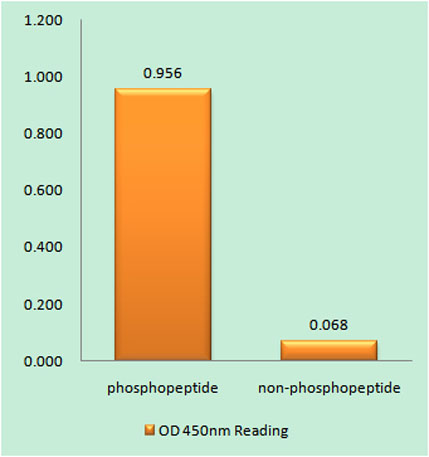
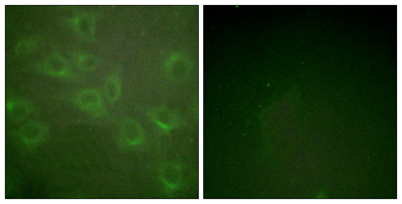
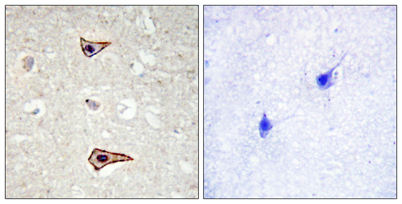
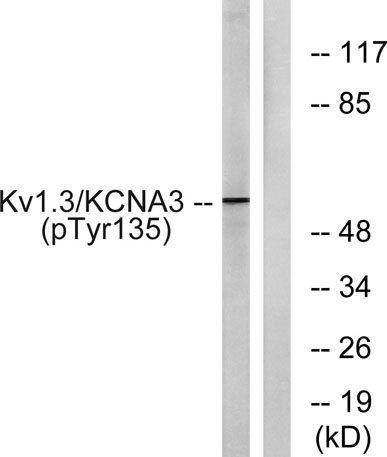
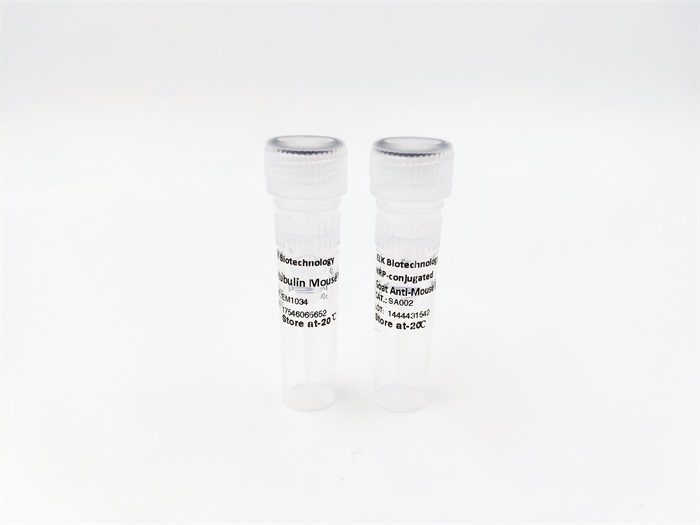



Kv1.3 (phospho Tyr187) rabbit pAb
 One-click to copy product information
One-click to copy product information$148.00/50µL $248.00/100µL
| 50 µL | $148.00 |
| 100 µL | $248.00 |
Overview
| Product name: | Kv1.3 (phospho Tyr187) rabbit pAb |
| Reactivity: | Human;Mouse;Rat |
| Alternative Names: | KCNA3; HGK5; Potassium voltage-gated channel subfamily A member 3; HGK5; HLK3; HPCN3; Voltage-gated K(+) channel HuKIII; Voltage-gated potassium channel subunit Kv1.3 |
| Source: | Rabbit |
| Dilutions: | Western Blot: 1/500 - 1/2000. Immunohistochemistry: 1/100 - 1/300. Immunofluorescence: 1/200 - 1/1000. ELISA: 1/20000. Not yet tested in other applications. |
| Immunogen: | The antiserum was produced against synthesized peptide derived from human Kv1.3/KCNA3 around the phosphorylation site of Tyr135. AA range:101-150 |
| Storage: | -20°C/1 year |
| Clonality: | Polyclonal |
| Isotype: | IgG |
| Concentration: | 1 mg/ml |
| Observed Band: | 58kD |
| GeneID: | 3738 |
| Human Swiss-Prot No: | P22001 |
| Cellular localization: | Cell membrane ; Multi-pass membrane protein. |
| Background: | Potassium channels represent the most complex class of voltage-gated ion channels from both functional and structural standpoints. Their diverse functions include regulating neurotransmitter release, heart rate, insulin secretion, neuronal excitability, epithelial electrolyte transport, smooth muscle contraction, and cell volume. Four sequence-related potassium channel genes - shaker, shaw, shab, and shal - have been identified in Drosophila, and each has been shown to have human homolog(s). This gene encodes a member of the potassium channel, voltage-gated, shaker-related subfamily. This member contains six membrane-spanning domains with a shaker-type repeat in the fourth segment. It belongs to the delayed rectifier class, members of which allow nerve cells to efficiently repolarize following an action potential. It plays an essential role in T-cell proliferation and |
-
 Enzyme-Linked Immunosorbent Assay (Phospho-ELISA) for Immunogen Phosphopeptide (Phospho-left) and Non-Phosphopeptide (Phospho-right), using Kv1.3/KCNA3 (Phospho-Tyr135) Antibody
Enzyme-Linked Immunosorbent Assay (Phospho-ELISA) for Immunogen Phosphopeptide (Phospho-left) and Non-Phosphopeptide (Phospho-right), using Kv1.3/KCNA3 (Phospho-Tyr135) Antibody -
 Immunofluorescence analysis of HUVEC cells, using Kv1.3/KCNA3 (Phospho-Tyr135) Antibody. The picture on the right is blocked with the phospho peptide.
Immunofluorescence analysis of HUVEC cells, using Kv1.3/KCNA3 (Phospho-Tyr135) Antibody. The picture on the right is blocked with the phospho peptide. -
 Immunohistochemistry analysis of paraffin-embedded human brain, using Kv1.3/KCNA3 (Phospho-Tyr135) Antibody. The picture on the right is blocked with the phospho peptide.
Immunohistochemistry analysis of paraffin-embedded human brain, using Kv1.3/KCNA3 (Phospho-Tyr135) Antibody. The picture on the right is blocked with the phospho peptide. -
 Western blot analysis of lysates from Jurkat cells treated with starved 24h, using Kv1.3/KCNA3 (Phospho-Tyr135) Antibody. The lane on the right is blocked with the phospho peptide.
Western blot analysis of lysates from Jurkat cells treated with starved 24h, using Kv1.3/KCNA3 (Phospho-Tyr135) Antibody. The lane on the right is blocked with the phospho peptide.

 Manual
Manual